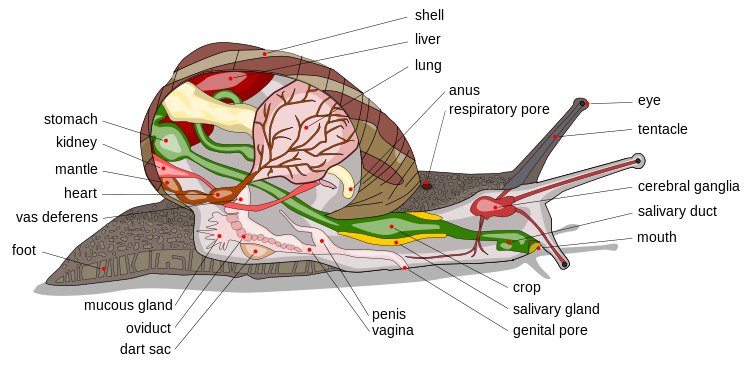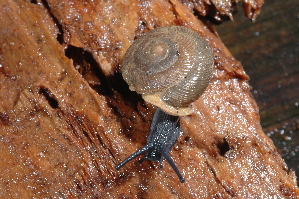Nutrition
Patera appressa, like the majority of other snails, are not picky eaters. Food is one of the few ways, other than finding a mate, that will cause a snail to actively move around (Turgeon, 1998). Patera appressa will primarily use its sense of smell with the chemoreceptors located in their four tentacles to find a source of food and then slowly move to it, as they generally feed at night (Turgeon, 1998). Patera appressa, like most snails has an herbivore diet consisting of a variety of plants and fungi, but will eat almost anything in its crawling path (Speiser, 2001). Snails also require a diet that is high in calcium for optimum shell strength and growth (Speiser, 2001).
When food is found, a snail will grasp it with its foot and mouth. Then a radula will emerge from the mouth, which is a tongue-like structure than contain many teeth made of chitin that can break off small parts of food that will then go to the esophagus of the snail (Mackenstedt and Market, 2001). In research conducted by Dimitriadis, the food is then mixed with saliva from a salivary duct and moved through the esophagus via muscular contractions into the crop where food can be stored. From there, food is mixed with digestive juices and moved to the gastric pouch or stomach, which is the most important of a snail as this organ excretes bodily wastes, regulates body chemistry to maintain homeostasis, and absorbs the nutrients of food. The food is then moved into the intestine where nutrients can be absorbed and the waste products can be moved to the anus for excretion (Dimitriadis, 2001).

Since snails do not move very much, they have an open circulatory system that pumps hemolymph into the hemocoel, or body cavity (glencoe.mcgraw-hill.com, 2011). Hemolymph is pumped from the heart through blood vessels but then enters body cavities and moves to the surrounding tissues as well as surrounding the organs themselves(faculty.clintoncc.suny.edu, 2012). With being pumped out of blood vessels there is no blood pressure so the snail must move muscles to move hemolymph in the tissues and around organs (faculty.clintoncc.suny.edu, 2012). But energy and nutrients will be absorbed from food in the intestine and move into the hemolymph, where muscles can contract the fluid back to the heart and be pumped to all the other organs (faculty.clintoncc.suny.edu, 2012).
